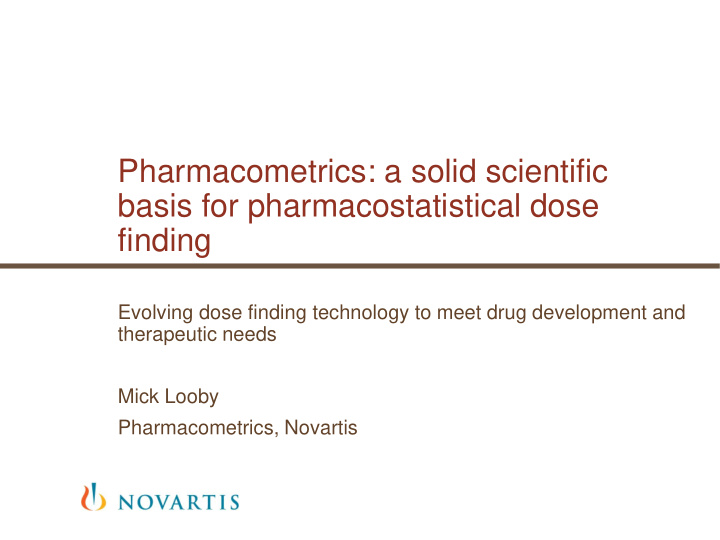



Pharmacometrics: a solid scientific basis for pharmacostatistical dose finding Evolving dose finding technology to meet drug development and therapeutic needs Mick Looby Pharmacometrics, Novartis
What is Pharmacometrics? The quantitative science of drug action Pharmacometrics (“measuring pharmacology”) is a discipline that integrates biology, pharmacology, physiology and pathophysiology in mathematical and statistical models to describe and quantify the interactions between drugs and patients. Pharmacometric principles provide the framework which help elucidate drug action and build our models. Pharmacometric models quantify the relationships between drug administered, covariates, exposure and responses (biomarkers, efficacy, safety) as they evolve over time in both individual patients and populations. Pharmacometric models are pharmacostatistical models In drug development, pharmacometric models can be used to inform decisions on development strategy (e.g. study design) and therapeutic use (e.g. dose, regimen and population) through simulation of specific scenarios . 2 | EMA EFPIA Workshop | M Looby | 4.12.2014 | PMX & Dose Finding
Pharmacometric conceptual model of drug action “It is all about the signal” K in R E S D O P Biosignal C e C p O S E N S K out E Jusko, Ko, Ebling 1995 Biosensor Disposition Biophase Biosignal Trans- process kinetics distribution flux duction PMX focuses on the key signals and their transformations from dose to response PMX recognizes the systematic factors in the drivers of drug responses 3 | EMA EFPIA Workshop | M Looby | 4.12.2014 | PMX & Dose Finding
The things we measure in the chain of drug action Naming the pieces Pharmacokinetics Pharmacodynamics ‘What the body does to the drug’ ‘What the drug does to the body’ Exposure Site of Dose Biosignal Response regimen action Safety Biomarkers Dose PK ‘drug related responses’ Tolerability ‘concentration profile’ Dosage Interval Efficacy Route of administration Clinical Readouts Delivery system Outcomes Influencing Factors ‘Covariates’ • Demographics • Pathophysiology • Treatment Duration • Treatment Combinations • Formulation 4 | EMA EFPIA Workshop | M Looby | 4.12.2014 | PMX & Dose Finding
How does PMX support DR assessment? Uses domain science to characterize signal We are not interested in only “ dose” , but also: • The response signal within its pharmacological context - Dose, regimen, exposure and response as it evolves over time - Sources of nonlinearity - Rate limiting steps - Real-time changes in therapy - Steady-state vs non-steady-state - Delays between doses and responses - Stationarity (Change in ‘system properties’ over time) • The individual patient within its population as the unit of observation - Between- and within-patient variability 5 | EMA EFPIA Workshop | M Looby | 4.12.2014 | PMX & Dose Finding
Response usually longitudinal, DR assessment usually cross-sectional Traditionally DR is cross-setional Dose Pharmacological drug responses are 100X usually longitudinal and very often a continuous measurement Pharmacostatistical PMX model 10X based methods can account for longitudinal response across a wide range of different doses and regimens. 1X • Heterogeneity, in input signals, if appropriately designed, increase overall understanding of system response properties 100X However, traditionally DR is 10X assessed cross-sectionally (e.g. a specific study visit), for a given regimen, and often transformed to a dichotomized variable 1X 6 | EMA EFPIA Workshop | M Looby | 4.12.2014 | PMX & Dose Finding Dose
Assumptions and limitations of cross-sectional DR Traditional methods not adequate in many therapeutic settings What are the ‘cross - sectional’ assumptions? • Treatment is ‘simple’, e.g. a dose for a given regimen • Steady-state is attained • Steady-state conditions remain constant - Response does not change over time - Treatment does not change over time • Variability mainly between-patient When are cross-sectional approaches inefficient? • Low signal to noise ratio, if repeated measures are not considered • Elucidating dose and regimen for long-acting drugs with long dose intervals (e.g mAb) • Loading regimens with maintenance doses (“treatment is not simple”) • Individualization of therapy When will ‘cross - sectional’ not work? • Many non-steady-state therapies (e.g. acute treatments) • Combining different treatment schedules within or across different studies • Loading regimens with maintenance doses and delayed responses • ‘Responsiveness’ changes over time • Individualization of therapy | EMA EFPIA Workshop | M Looby | 4.12.2014 | PMX & Dose Finding 7
The price and the pay-off of PMX informed approaches PMX methods extend the range of our pharmacostatistical tools Price Pay-off • More complex design • More informative PII designs considerations - Greater confidence in treatments to be assessed in - e.g. forced-titrations PIII - Randomized washouts - Can combine different - Wide range of doses, regimens ‘treatments’ within or across and routes of administration may studies to learn about dose- [have to] be considered exposure-response - May require combination of more - Can better consider the means than 1 study of therapy individualization and - Require model based analysis its benefits methods • Gain in capacity to learn about • Potential loss of confirmatory treatment options for a given discrimination pharmacotherapy • Potentially more expensive PII 8 | EMA EFPIA Workshop | M Looby | 4.12.2014 | PMX & Dose Finding
Pharmacometric principles: why they are important Integration of PMX methods can change how we develop drugs PMX does not replace ‘ pharmacostatistics ’, it extends it. • To ensure optimal dose finding on each program, we must prospectively assess where: 1. PMX may add to aid program design and analysis [or not] 2. PMX principles and methods may support traditional design and analysis planning 3. PMX methods may be the most efficient means of addressing program needs To improve dose finding, we need developers and regulators with: 1. the knowledge to consider where PMX principles add value [or not] 2. the skills to implement PMX methods when necessary 3. and the fortitude to continually evolve how we develop new drugs to meet development and therapeutic needs 9 | EMA EFPIA Workshop | M Looby | 4.12.2014 | PMX & Dose Finding
Recommend
More recommend